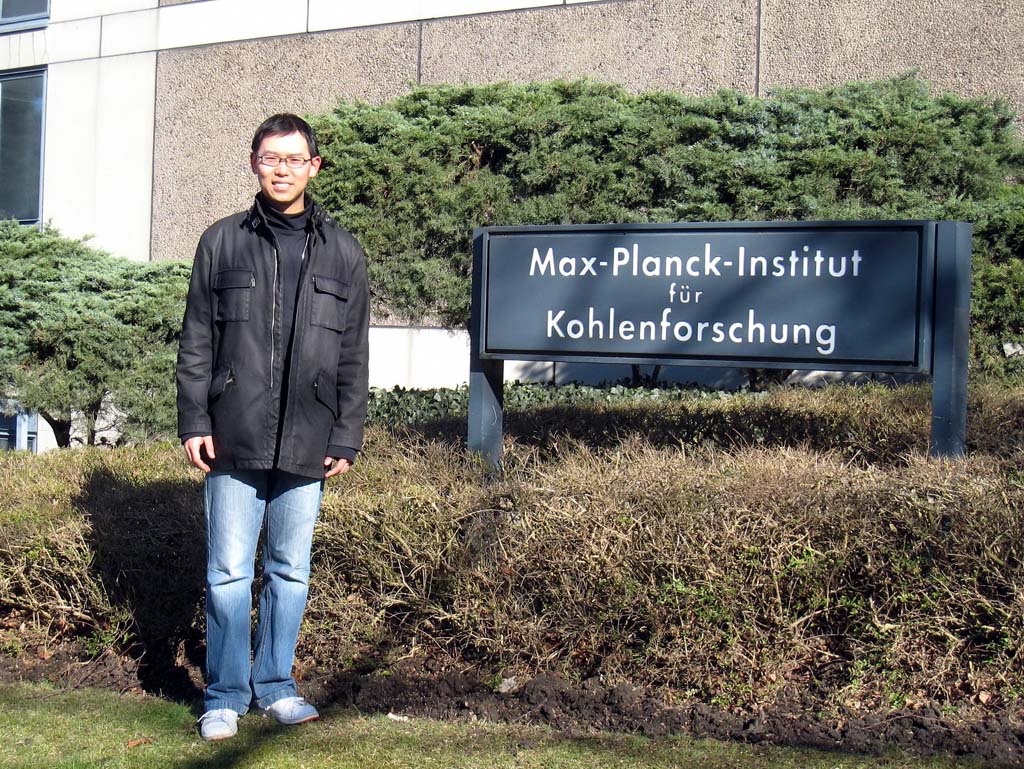
EDUCATION
2000.9 - 2004.6 Nankai University, College of Chemistry, B. S.
2004.9 - 2009.6 Nankai University, SKLEOC, Ph. D.
2009.12 - Now Max-Planck-Institut für Kohlenforschung
CONTACT
E-Mail:
This email address is being protected from spambots. You need JavaScript enabled to view it.
Address: Max-Planck-Institut für Kohlenforschung, Kaiser-Wilhelm-Platz, 145470, Mülheim an der Ruhr, Germany
DISSERTATION
< 铱络合物催化a,b-不饱和羧酸不对称氢化反应研究>
Abstract
Optically active carboxylic acids are indispensable building blocks for asymmetric synthesis in pharmaceutical industry and total synthesis of natural products. Transition-metal-catalyzed asymmetric hydrogenation of prochiral unsaturated carboxylic acids represents one of the most efficient and atom-economic methods for preparing chiral carboxylic acids and has drawn increasing attention in both academic research and industrial production. In the past decades, a variety of Ru and Rh catalysts have been developed for the hydrogenation of different unsaturated carboxylic acids in high enantioselectivities. However, the efficiency of the Ru and Rh catalysts is highly substrate-dependent. For most reported catalysts, high catalyst loading, drastic reaction conditions, or long reaction time are often needed for achieving satisfactory results. Thus, more efficient chiral catalysts are highly desirable in this useful reaction.
The chiral Ir catalysts, which are very efficient in the hydrogenation of unfunctionalized olefins and imines, have long been neglected in the hydrogenation of unsaturated carboxylic acids. In this dissertation, we demonstrated that the chiral spiro iridium/P,N-ligand complexes were highly effective catalysts for the asymmetric hydrogenation of various a,b-unsaturated carboxylic acids, providing optically active carboxylic acids in extremely high activities and enantioselectivities under mild conditions.
We reported a detailed investigation of asymmetric hydrogenation of trisubstituted a,b-unsaturated carboxylic acids using chiral spiro iridium complexes as catalysts. Comparison of the catalysts led to the finding that the chiral spiro iridium/phosphine-oxazoline complexes which have bulky 3,5-di-tert-butyl substituents on the P-phenyl rings were the most efficient catalysts. We also found the addition of basic additives could improve both reaction rate and enantioselectivity. Under the optimal conditions, a variety of a-alkyl cinnamic acid derivatives, tiglic acid derivatives, a-aryloxy and a-alkoxy a,b-unsaturated carboxylic acids were hydrogenated to the corresponding chiral saturated acids in excellent activities, enantioselectivities with broad substrate scopes.
A mechanism involving a catalytic cycle between IrI and IrIII was proposed based on the coordination model of the unsaturated acids to the iridium metal center. The rationality of the catalytic cycle, with an olefin dihydride complex as the key intermediate, was supported by the deuterium-labeling studies. The X-ray diffraction analysis of the catalysts revealed that the rigid and steric hindered chiral spiro phosphino-oxazoline ligands created an efficient chiral environment around the metal center of the catalyst, which is the essence for obtaining the excellent chiral discrimination in the hydrogenation of unsaturated acids. A chiral induction model was suggested based on the catalyst structure and the product configuration.
We also reported an investigation of asymmetric hydrogenation of a-substituted acrylic acids using chiral spiro iridium complexes as catalysts. A chiral spiro iridium/phosphine-imine complexe was proved to be the most efficient catalysts. Under the optimal conditions, a variety of a-substituted acrylic acids could be hydrogenated in high enantioselectivities under mild reaction conditions, providing optically active a-substituted propionic acids.
key words: iridium complexe, chiral spiro P,N-ligand, asymmetric hydrogenation, unsaturated carboxylic acid, chiral carboxylic acid
PUBLICATION
1.Jian-Βo Xie, Jian-Hua Xie*, Xiao-Yan Liu, Wei-Ling Kong, Shen Li, and Qi-Lin Zhou*, Highly enantioselective hydrogenation of α-arylmethylene cycloalkanones catalyzed by iridium complexes of chiral spiro aminophosphine ligands, J. Am. Chem. Soc. 2010, 132, 4538-4539.
2.Shen Li, Shou-Fei Zhu, Jian-Hua Xie, Song Song, Can-Ming Zhang, and Qi-Lin Zhou*, Enantioselective hydrogenation of α-aryloxy and α-alkoxy α,β-unsaturated carboxylic acids catalyzed by chiral spiro iridium/phosphino-oxazoline complexes, J. Am. Chem. Soc. 2010, 132, 1172-1179.
3.Shen Li, Shou-Fei Zhu, Can-Ming Zhang, Song Song, Qi-Lin Zhou*, Iridium-catalyzed enantioselective hydrogenation of α,β-unsaturated carboxylic acids,J. Am. Chem. Soc. 2008, 130, 8584-8585.
4.Bao-Min Fan, Jian-Hua Xie, Shen Li, Li-Xin Wang, Qi-Lin Zhou*, Highly enantioselective silylcarbocyclization of 1,6-enynes catalyzed by Rh(I)-SDP complexes, Angew. Chem. Int. Ed. 2007, 46, 1275-1277.
5. Shou-Fei Zhu, Jian-Βo Xie, Yong-Zhen Zhang, Shen Li, Qi-Lin Zhou*, Well-defined chiral spiro Ir/phosphine-oxazoline cationic complexes for highly enantioselective hydrogenation of imines at ambient pressure,J. Am. Chem. Soc. 2006, 128, 12886-12891.
6.Bao-Min Fan, Shen Li, Jian-Hua Xie, Li-Xin Wang, Yong-Qiang Tu, Qi-Lin Zhou*, Rhodium-catalyzed asymmetric Pauson-Khand reaction using SDP ligands, Science in China: Series Β Chemistry 2006, 49(1), 81-87 (中国科学B辑 化学 2005, 35(5): 390-395).
7.Bao-Min Fan, Jian-Hua Xie, Shen Li, Yong-Qiang Tu, Qi-Lin Zhou*, Rhodium-catalyzed asymmetric Pauson-Khand reaction using monophosphoramidite ligand SIPHOS, Adv. Synth. Catal. 2005, 347, 759-762.

